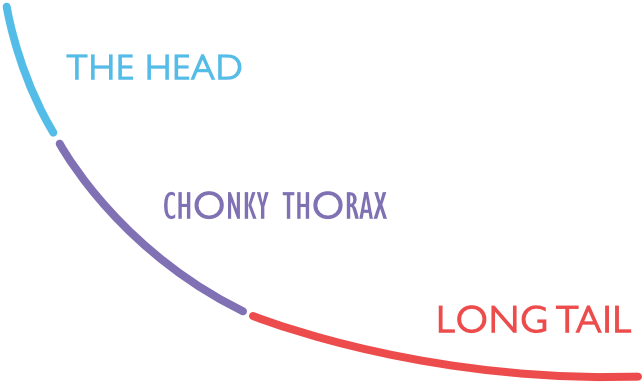Head keywords. Long-tail keywords. The chunky middle. The chonky thorax. Is it any wonder why most people outside of SEO think we’re talking gibberish? Ask a dozen SEOs what keywords qualify as “long-tail” and you’ll get 13 opinions and 17 fistfights.
What we can agree on is that — due to Google’s advancements in Natural Language Processing (NLP) — the long tail of search has exploded. However, I will argue that NLP has also imploded the long tail, and understanding how and why may save our collective sanity.
Table of Contents
What is the long tail of SEO, exactly?
The long tail of search is the limitless space of low-volume (and often low-competition) keywords. Tactically, long-tail SEO centers on competing for a large number of low-volume keywords instead of focusing on a small set of high-volume keywords.
Long-tail SEO encourages us to let go of vanity, because high-volume, so-called “vanity” keywords are often out of reach or, at best, will empty our bank accounts. Low-volume keywords may be less attractive on the surface, but as you begin to compete on hundreds or thousands of them, they represent more traffic and ultimately more sales than a few vanity keywords.
You’ve probably seen a graph of the long tail like the one above. It’s a perfectly lovely power curve, but it’s purely hypothetical. And while you may smile and nod when you see it, it’s hard to translate this into a world of keywords. It might help to re-imagine the long tail of SEO:
I’m not sure the “reclining snowman of SEO” is ever going to catch on, but I think it helps to illustrate that — while head keywords are high-volume by themselves — the combined volume of the long tail eclipses the head or the middle. Like the familiar curve, this visualization dramatically underestimates the true scope of the long tail.
What are long-tail keywords?
In the words of the ancient SEOs, “It doth depend.” Typically, long-tail keywords are low-volume, multi-word phrases, but the long-tail is relative to your starting point. Historically, any given piece of the long tail was assumed to be low-competition, but that’s changing as people realize the benefits of targeting specific phrases with clear intent (especially commercial intent).
Targeting “widgets” is not only expensive, but searcher intent is ambiguous. Targeting “buy blue widgets” narrows intent, and “where to buy Acme Widget LOL-42” laser-focuses you on a target audience. As searchers and SEOs adapt to natural language search, previously “long-tail” keywords may become higher volume and higher competition.
The long tail has exploded
Google has told us that 15% of the searches they see every day are new. How is this possible? Are we creating that many new words? That’s sus, bruh!
I can explain it to you in a very short story. The other day, my (half-Taiwanese) 10-year-old daughter couldn’t remember what her Chinese zodiac sign was, so she asked Google Home:
Hey, Google, what’s the animal for the Chinese new year calendar thingy for 2010?
It’s easy to get hung up on the voice-appliance aspect of this, but whether or not you believe in the future of voice appliances, the reality is that voice search in general has driven the need for natural language search, and as Google becomes better at handling natural language, we’re reverting to using it more often (it’s our default mode). This is especially evident in kids, who never had to learn to dumb down their searches for antiquated algorithms.
How can we hope to target keyword phrases that are literally evolving as we speak? Fortunately, NLP cuts both ways. As Google understands context better, the algorithm recognizes that many variations of the same phrase or question are essentially the same. Which leads us to…
The long tail has imploded
Back in 2019, I did a keyword research case study at SearchLove London on UK mega-retailer, John Lewis. In my research, I was surprised to see how many searches Google was automatically redirecting. There’s the obvious, like Google assuming that people who searched for “Jon Lewis” in the UK probably meant “John Lewis” (sorry, Jon):
It’s interesting to note that Google has gradually, quietly moved from the previously more prevalent “Did you mean?” to the more assertive (some might say aggressive) “Showing results for…” In this case, optimizing for Jon Lewis in the UK is probably pointless.
I expected a rabbit hole, but I landed in a full-on bunny chasm. Consider this search:
Hjohjblewis?! I landed on this misspelling entirely by accident, but I imagine it involved an attention-starved cat and cat-adjacent keyboard. This level of rewriting/redirecting was shocking to me.
Misspellings are just the beginning, however. What about very similar long-tail phrases that don’t surface any kind of rewrite/redirect, but show very similar results?
Note that this same set of terms in the US overwhelmingly returns results about former US Representative and civil rights leader, John Lewis, demonstrating just how much not only intent can shift across localities, but how Google’s re-interpretations can change dynamically.
That same year, I did an experiment for MozCon targeting long-tail questions, such as “Can you reverse a 301-redirect?”, demonstrating that posts written around a specific question could often rank for many forms of that question. At the time, I didn’t have a way to measure this phenomenon, other than showing that the post ranked for variations of the phrase. Recently, I re-analyzed my 2019 keywords (with rankings from April 2021) using a simplified form of Rank-Biased Overlap (RBO) called RBOLite. RBOLite scores the similarity between two rank-ordered lists, yielding a score from 0-1. As the name implies, this score biases toward the higher-ranked items, so a shift at #1 will have more impact than a shift at #10.
Here are the scores for a sampling of the phrases I tracked for the 2019 post, with the title of the post shown at the top (and having a perfect match of 1.0):
You can see visually how the similarity of the results diverges as you change and remove certain keywords, and how this creates a complex interaction. What’s fascinating to me is that changing the question phrase from “Can you” to “How do you” or “How to” made very little difference in this case, while removing either “301” or “redirect” had more impact. Switching “you” vs. “I” by itself was fairly low impact, but was additive with other changes. Even the SERPs with “undo” in place of “reverse” showed fairly high similarity, but this change showed the most impact.
Note that the week-over-week RBOLite score for the initial phrase was 0.95, so even the same SERP will vary over time. All of these scores (>0.75) represent a fair degree of similarity. This post ranked #1 for many of these terms, so these scores often represent shifts farther down the top 10.
Here’s another example, based on the question “How do I improve my domain authority?”. As above, I’ve charted the RBOLite similarity scores between the main phrase and variations. In this case, the week-over-week score was 0.83, suggesting some background flux in the keyword space:
One immediately interesting observation is that the difference between “improve” and “increase” was negligible — Google easily equated the two terms. My time spent debating which keyword to use could’ve been spent on other projects, or on eating sandwiches. As before, switching from “How do I” to “How do you” or even “How to” made relatively little difference. Google even understood that “DA” is frequently substituted for “Domain Authority” in our industry.
Perhaps counterintuitively, adding “Moz” made more of a difference. This is because it shifted the SERP to be more brand-like (Moz.com got more mentions). Is that necessarily a bad thing? No, my post still ranked #1. Looking at the entire first page of the SERPs, though, adding the brand name caused a pretty clear intent shift.
The long tail is dead. Long live the long tail.
In the past decade, the long tail has exploded and then imploded (in many ways, due to the same forces), and yet somehow we’ve landed in a very different keyword universe. So, where does that leave us — the poor souls fated to wander that universe?
The goods news of this post (I hope) is that we don’t have to work ourselves to death to target the long tail of search. It doesn’t take 10,000 pieces of content to rank for 10,000 variants of a phrase, and Google (and our visitors) would much prefer we not spin out that content. The new, post-NLP long tail of SEO requires us to understand how our keywords fit into semantic space, mapping their relationships and covering the core concepts. While our tools will inevitably improve to meet this challenge (and I’m directly involved in such projects at Moz), our human intuition can go a long way for now. Study your SERPs diligently, and you can find the patterns to turn your own long tail of keywords into a chonky thorax of opportunity.




